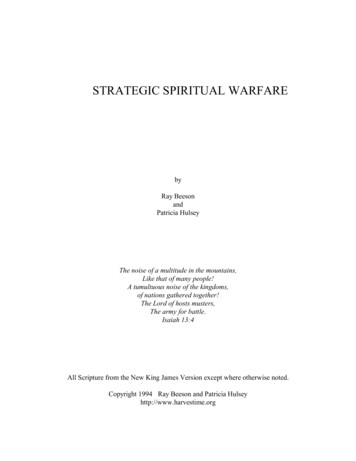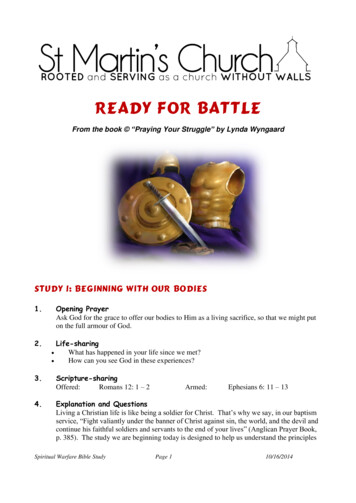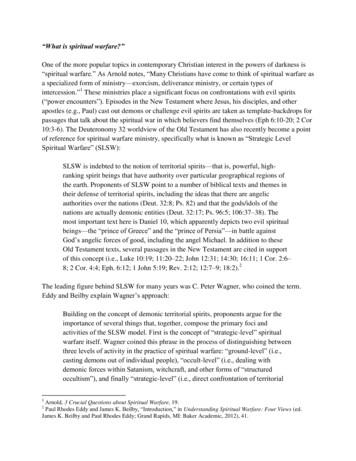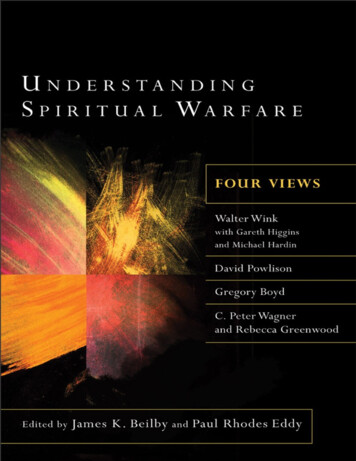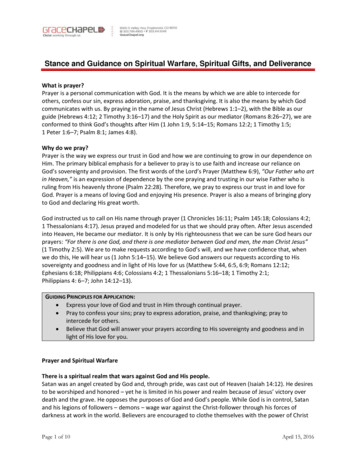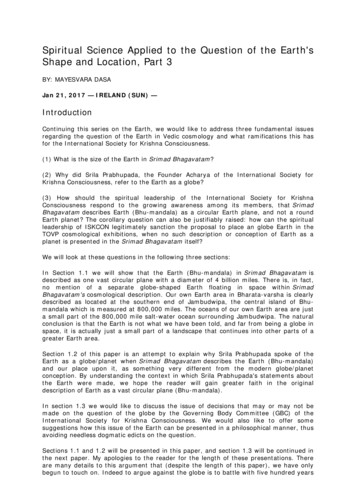
Transcription
Spiritual Science Applied to the Question of the Earth'sShape and Location, Part 3BY: MAYESVARA DASAJan 21, 2017 — IRELAND (SUN) —IntroductionContinuing this series on the Earth, we would like to address three fundamental issuesregarding the question of the Earth in Vedic cosmology and what ramifications this hasfor the International Society for Krishna Consciousness.(1) What is the size of the Earth in Srimad Bhagavatam?(2) Why did Srila Prabhupada, the Founder Acharya of the International Society forKrishna Consciousness, refer to the Earth as a globe?(3) How should the spiritual leadership of the International Society for KrishnaConsciousness respond to the growing awareness among its members, that SrimadBhagavatam describes Earth (Bhu-mandala) as a circular Earth plane, and not a roundEarth planet? The corollary question can also be justifiably raised: how can the spiritualleadership of ISKCON legitimately sanction the proposal to place an globe Earth in theTOVP cosmological exhibitions, when no such description or conception of Earth as aplanet is presented in the Srimad Bhagavatam itself?We will look at these questions in the following three sections:In Section 1.1 we will show that the Earth (Bhu-mandala) in Srimad Bhagavatam isdescribed as one vast circular plane with a diameter of 4 billion miles. There is, in fact,no mention of a separate globe-shaped Earth floating in space within SrimadBhagavatam's cosmological description. Our own Earth area in Bharata-varsha is clearlydescribed as located at the southern end of Jambudwipa, the central island of Bhumandala which is measured at 800,000 miles. The oceans of our own Earth area are justa small part of the 800,000 mile salt-water ocean surrounding Jambudwipa. The naturalconclusion is that the Earth is not what we have been told, and far from being a globe inspace, it is actually just a small part of a landscape that continues into other parts of agreater Earth area.Section 1.2 of this paper is an attempt to explain why Srila Prabhupada spoke of theEarth as a globe/planet when Srimad Bhagavatam describes the Earth (Bhu-mandala)and our place upon it, as something very different from the modern globe/planetconception. By understanding the context in which Srila Prabhupada's statements aboutthe Earth were made, we hope the reader will gain greater faith in the originaldescription of Earth as a vast circular plane (Bhu-mandala).In section 1.3 we would like to discuss the issue of decisions that may or may not bemade on the question of the globe by the Governing Body Committee (GBC) of theInternational Society for Krishna Consciousness. We would also like to offer somesuggestions how this issue of the Earth can be presented in a philosophical manner, thusavoiding needless dogmatic edicts on the question.Sections 1.1 and 1.2 will be presented in this paper, and section 1.3 will be continued inthe next paper. My apologies to the reader for the length of these presentations. Thereare many details to this argument that (despite the length of this paper), we have onlybegun to touch on. Indeed to argue against the globe is to battle with five hundred years
of so-called science from which our present construct of reality has been formed. Wehope, at least, that the citations from Srimad Bhagavatamand Srila Prabhupada canserve as a reference for further discussion and debate. My apologies also for a certainrepetition in the presentation, as the same subject matter has to be defended fromvarious angles.The topic of the Earth should be of interest not just to those studying Vedic cosmology,but to everyone of us who live here upon the Earth. What does SrimadBhagavatam's description of a greater Earth plane mean for us in the apparent 'realworld' of the so-called Earth globe? Just maybe, Srimad Bhagavatam's description of agreater Earth plane means that the world we thought was real, is not, and that Krishnathrough the medium of Srimad Bhagavatam is actually trying to wake us up out of ourignorance and illusion regarding who we are, and where we are in the vast creation."This Bhagavata Purana is as brilliant as the sun, and it has arisen just after thedeparture of Lord Krishna to His own abode, accompanied by religion, knowledge,etc. Persons who have lost their vision due to the dense darkness of ignorance inthe age of Kali shall get light from this Purana."(SB 1.1.3)It is really quite alarming, that in spite of Srimad Bhagavatam's clear description ofBharata-varsha's position on a vast circular Earth plane, the present management of theMayapur Temple of Vedic Planetarium (who are supposed to be presenting SrimadBhagavatam as a factual description of the universe), flatly refuse to acknowledge eventhe possibility that this may be a true account of our Earth. There are powerfulramifications to Srimad Bhagavatam's description of Bharata-varsha's location toJambudwipa that the present TOVP management simply do not want to deduce: if ourown area of Bharata-varsha is surrounded by vast lands and oceans calculated athundreds of millions of miles, then Earth is not a globe, and our life on Earth must be avery different one from this day on. The shocking discovery that one's beloved Earth isnot a globe floating in space, is like the foul discovery that one's beloved partner ishaving sex with another person. At first one cannot believe such a thing to be true, orwhy and how their partner could cheat them in such a way; but as the truth is graduallyrevealed, one realizes that one's world will never be the same again. Likewise thediscovery that the Earth is not a globe in space, spells the end of the world as we knowit. The discovery of the truth about the Earth begins with a description of a very differentEarth spoken five thousand years ago.(Section 1.1) WHAT IS THE SIZE OF THE EARTH IN SRIMADBHAGAVTAM?In part two of this paper, which can be found here, we raised the subject of KingPariksit inquiring from his guru Sukadeva Goswami about the measurement andcharacteristics of the Earth. The context of this inquiry is significant. King Pariksit hadonly seven days to live and wanted to know 'the way of perfection' before his time ofdeath came. This raises the interesting question of why a dying king would want to knowabout the size of the Earth. Is the size of the Earth a pressing question on the minds ofmost people about to die, and especially for the devotees of Krishna who are taught toconcentrate their minds on the personal form of Krishna as they prepare for leaving theirmaterial body? The question, in fact. is only one of many subjects that King Pariksitinquired about in regards to the satyam param or absolute truth. This particular question,however, is one of the essential items that one should know about the world, its creator,and our relationship to both.In part two, we looked at how this question led to a description of the virtarupa. The virat-rupa refers to the concept of Krishna's manifestation as the universeitself. Sukadeva Goswami taught his disciple King Pariksit how to see the universe withspiritual eyes, and particularly how to perceive the universe as an expansion of Krishnathat is simultaneously one and different from the Lord Himself. The virta-rupa conceptleads to an appreciation of all things within the material world as part and parcel ofKrishna, and therefore sacred and worthy of love and respect. This is a truly edifying
area of spiritual science which unfortunately we could only touch on briefly in part two. Inthis paper, we will look at the specific details of the question relating to the size andcharacteristics of the Earth. The question is relevant to our inquiry about the truth of theglobe concept of the Earth because as it turns out, the Earth described in SrimadBhagavatam is actually the biggest feature in the universe, and not a small globe inspace as we are meant to believe.We shall see presently that Sukadeva Goswami presents very exact numerical distances,precise geometrical shapes, and specific names in his description of the Bhu-mandala(the Earth circle). The description is in every way 'scientific.' Science allows us to 'know'something of the thing being studied. If one receives a description of a certain object,one can know it to some degree. Sometimes we are asked to fetch something unfamiliarand a brief description is all we need to help us identify the thing. For some unacquaintedwith a harmonium, a brief description of a small piano-like instrument is all that isrequired to enable the person to distinguish the desired instrument from otherinstruments such as a mridanga drum or a stringed instrument like a sitar. Likewise, astudy of Sukadeva Goswami's description of the Earth allows us to 'see' and 'know' thereal feature of the world, even if we can't see the full extent of the Earth plane with ourown eyes. The description of the Earth in Srimad Bhagavatam also provides analternative model by which we can question if the image and description of the Earthpresented by NASA is actually real, or indeed, merely part of a crude and farcicalconspiracy that hides the real feature of the Earth.It may seem a strange proposition that an ancient scripture from India can be employedto question the truth of the modern Earth globe. Generally, people have an almostunquestioned faith that modern technological advances have put men and satellites inspace, proving once and for all, that the true shape and nature of the Earth is that of aglobe floating in dark space. Can this presentation of the Earth as a globe in space bequestioned by the International Society for Krishna Consciousness? The answer to thatquestion depends on how much faith the members of the society have in either theversion of Srimad Bhagavatam, or the version of modern science and so-called spaceagencies such as NASA and ESA. For one who accepts Krishna as the SupremePersonality of Godhead, (and thus accepts Krishna as the original creator of the Earth),Krishna's description of the Earth is the one that should obviously be accepted by adevotee. However, since the description of Earth in Srimad Bhagavatam has nothingwhatsoever in common with the modern Earth globe, the disparity in world-views mayobviously create difficulties for those devotees with a strong faith in science and thepresent world paradigm, but a weak faith in shabda brahman (spiritual knowledge). Inthe Srimad Bhagavatamit is stated:I meditate upon that pure and spotless Supreme Absolute Truth, who is free fromsuffering and death, and who in the beginning personally revealed this incomparabletorchlight of knowledge to Brahma. Brahma then spoke it to the sage Narada, whonarrated it to Krishna-dvaipayana Vyasa. Srila Vyasa revealed this Bhagavatam to thegreatest of sages, Sukadeva Gosvami, and Sukadeva mercifully spoke it to MaharajaPariksit. (SB 12.13.19)Here it says that the knowledge spoken in Srimad Bhagavatam was originally spoken byKrishna to Brahma. Brahma spoke Srimad Bhagavatam to Narada Muni, who thenpresented it to his disciple Vyasadeva. Vyasadeva taught Srimad Bhagavatam to his sonSukadeva Goswami, who in turn relayed the message to King Pariksit. Thetranscendental knowledge contained in Srimad Bhagavatam has thus been passed downfrom Sri Krishna Himself, through a disciplic succession that continues to the presentday. How do the present members of the disciplic succession understand the descriptionof the Earth that was originally spoken by Krishna? Have we got the right understanding?In the above verse, Sukadeva Goswami states: "I meditate upon the pure and spotlessSupreme Absolute Truth" (satyam param demahi). For atheists, this meditation on theabsolute truth means absolutely nothing; but at least for followers of SrimadBhagavatvam (who accept Krishna as the absolute truth) why should they doubt theversion of the Earth presented in Srimad Bhagavatam, over the version of Earth
constructed by a combination of modern speculative scientists, and notoriously deceptive'space' agencies like NASA?To repeat a few points made in previous papers: if we accept that Sukadeva Goswami isrelaying accurate information about the Earth from the creator of the Earth Himself (SriKrishna), then it is the photographs and videos of a very different looking Earth from theone described in Srimad Bhagavatam, that should be investigated as fabrications ofdeceptive agencies such as NASA. It is the quasi-science of Copernicus, Galileo, andNewton which supports this heliocentric version of the universe that should be regardedas speculative and make-believe, not the version of Sukadeva Goswami. This wouldmean having to consider the possibility that our perception of the Earth as a globe inspace has been fabricated, and the so-called Earth 'planet' we thought was real, is not.Finding no immediate reason to doubt the authenticity of such images provided by NASAand other space agencies, we assume that the version of Srimad Bhagavatam must beeither wrong, or describing something beyond our comprehension or dimension. Theinclination of the mind, intelligence, and false ego conditioned by the present 'scientific'paradigm of the Earth, is to immediately doubt the fantastic description of the greatEarth circle by the Vedic Rishis. One may favour NASA's images of the Earth globe oversome ancient yogi's description, simply because it is assumed that people in the past hadno accessibility to modern technology such as spacecraft and satellites that canphotograph and measure the Earth in its true feature. It does not enter a person's mindto question if such craft and satellites can actually make it into outer-space. Thespectacular images of astronauts hovering above the globe-shaped Earth as they fix theirInternational Space Station are so frequent, brilliant, and realistic, that to question theirreality is to have one's sanity questioned.What is real? For devotees of Krishna, the starting point to distinguish reality fromillusion is not the version of secular science, government, and media. The starting pointto distinguish reality from illusion is Srimad Bhagavatam.This Bhagavata Purana propounds the highest truth, which is understandable by thosedevotees who are fully pure in heart. The highest truth is reality distinguished fromillusion for the welfare of all. Such truth uproots the threefold miseries. (SB 1.1.2)It is not that because history, science, and government, teaches that the Earth is a globein space, that this must be accepted as our unquestioned reality and a reason to doubtthe version of Srimad Bhagavatam. Rather, the description of the Earth in SrimadBhagavatam is a reason to question the version of the Earth presented by science andgovernment. The question is this: is the science that has led us to believe that we live ona globe-shaped planet actually true? Does empirical science actually prove the roundglobe as a factual description of reality, or does empirical science prove the opposite –that the Earth can be observed and measured as a continual horizontal plane? Can weapply a spiritual science to test the claims of materialistic science?Srila Prabhupada set a spiritual revolution in motion with his rejection of the chemicalevolution of life theory, proving that it was not scientific at all, but simply the prejudiceidea of the atheistic disposition. Srila Prabhupada founded the Bhaktivedanta Institutewith the intention of using true science to prove the spiritual basis of life and theuniverse. The world-view of Srimad Bhagavatam is thus not a rejection of science in itstrue sense of the word, but rather a way to expose the speculative theories and outrightdeception of atheistic materialism that goes on in the name of 'science.' The cosmologysection in Srimad Bhagavatam is another area in which spiritual science disproves theclaims of modern atheistic science. Most spectacularly, Srimad Bhagavatam exposes thegreatest lie of all time - the Earth globe!The first andKing Pariksitthe variousfrom Srimadmost important point for followers of Srimad Bhagavatam to consider is thatspecifically asked for the 'names,' 'measurements,' and 'characteristics' offeatures on the Bhu-mandala or Earth circle. This series of versesBhagavatam should put to rest any further contentions that the Sanskrit
name Bhu-gola (round Earth/Earth circle) is describing the so-called Earth globe with acircumference of 24,900 miles. In Canto 5, Chapter 16, verses 1-2, Maharaja Pariksitrequests his guru Sukadeva Goswami, to describe the measurements and qualities of theseven islands and oceans of Bhu-mandala:"King Pariksit said to Sukadeva Gosvami: O brahmana, you have already informedme that the radius of Bhu-mandala extends as far as the sun spreads its light andheat and as far as the moon and all the stars can be seen.My dear Lord, the rolling wheels of Maharaja Priyavrata's chariot created sevenditches, in which the seven oceans came into existence. Because of these sevenoceans, Bhu-mandala is divided into seven islands. You have given a very generaldescription of their measurement, names, and characteristics. Now I wish to knowof them in detail. Kindly fulfil my desire." (SB 5.16.1-2)This is a very specific question requesting 'measurements' and 'characteristics', and thename Bhu-mandala is particularly invoked, along with its characteristic central feature ofseven islands (sapta-dwipa) and seven oceans (sapta-sindava). In reply to this question,Sukadeva Goswami states that there is no end to the Lords material energy, but that hewill try to explain the principle regions of Bhu-gola. Here the name Bhu-gola is usedsynonymously with Bhu-mandala:"The great Rsi Sukadeva Gosvami said: My dear King, there is no limit to theexpansion of the Supreme Personality of Godhead's material energy. This materialworld is a transformation of the material qualities [sattva-guna, rajo-guna andtamo-guna], yet no one could possibly explain it perfectly, even in a lifetime aslong as that of Brahma. No one in the material world is perfect, and an imperfectperson could not describe this material universe accurately, even after continuedspeculation. O King, I shall nevertheless try to explain to you the ir names,forms,measurements and various symptoms. (SB 5.16.4)bhu-golaka-visesam—the particular description of Bhuloka; nama-rupa—namesand forms; mana—measurements; laksanatah—according to symptoms;vyakhyasyamah—I shall try to explain."Note carefully that Pariksit Maharaja has asked for the 'names,' 'measurements'(manataha) and 'characteristics' (lakshanataha) of the Bhu-mandala (Earth circle).Sukadeva Goswami in reply gives him a very specific answer: bhu-golaka-visenam namarupa-mana-laksanato vyakhyasyamah: O King, I shall nevertheless try to explain to youthe principal regions, such as Bhu-goloka [Bhuloka], with their names, forms,measurements and various symptoms (SB 5.16.4). Again, the Sanskrit words and Englishsynonyms for this verse are: nama-rupa—names and forms; mana—measurements;laksanatah—according to symptoms; vyakhyasyamah—I shall try to explain.In the above two verses, the name Bhu-gola is used interchangeable with the name Bhumandala to refer to the same place – the Earth circle. We know the name Bhu-gola isused synonymously with Bhu-mandala because, as requested, Sukadeva Goswami thengoes on to explain the measurements and characteristics of the seven islands of Bhumandala up to the point of Lokaloka Mountain. The very name Bhu-gola indicates theEarth, and not the universe itself which is referred to using a whole different set ofnames such as anda, vishva, jagat, etc.Now why are these Sanskrit words and names significant? The Sanskrit words used hereare very significant because descriptions of 'names,' 'forms,' 'measurements,' and'characteristics' provide means by which we can identify a certain thing. The word sciencemeans 'to know,' meaning originally to separate or distinguish one thing from another. Adescription thus enables one to identify a certain place, object, or person, as well as todistinguish it from something else. By following a description, we can avoid confusion bymisidentifying one thing with another. By following Sukadeva Goswami's description of
the 'names,' 'form,' 'measurements,' and 'various symptoms' of the Bhu-gola or Earthcircle, we see that they do not match in any way, to the names, forms, measurements,and general characteristics of the assumed Earth globe in space. This is a most importantconsideration because part of the argument in favour of depicting the Earth as a globewithin the Temple Of Vedic Planetarium is to say that the name Bhu-gola is referring tothe Earth globe. The Sanskrit word gola, however, can refer to anything round and doesnot necessarily imply a globe or ball shape. It can also mean a circular shape like aroundabout or Frisbee. By following the actual description of Bhu-gola, we can see clearlythat Sukadeva Goswami is not describing the Earth or Bhu-gola as a globe in space, butrather, he is describing the Earth as a vast circular plane of 4 billion miles diameter. Thesize, location, and importance of the Earth or Bhu-gola is not an insignificant detail. TheBhu-gola is, in fact, the largest feature in the universe.In reply to King Pariksit's inquiry about the measurements and characteristics of theEarth circle, Sukadeva Goswami describes the seven islands and other features of Bhumandala up to the point of Lokaloka mountain. At this point Sukadeva Goswamisummarizes his description in SB 5.20.38. Therein he states:"Learned scholars who are free from mistakes, illusions and propensities to cheathave thus described the planetary systems and their particular symptoms,measurements and locations. With great deliberation, they have established thetruth that the distance between Sumeru and the mountain known as Lokaloka isone fourth of the diameter of the universe—or, in other words, 125,000,000yojanas [1 billion miles]." (SB 5.20.38)Thus, the distance from Mount Meru (center of the universe) to Lokaloka Mountain is125,000,000 yojanas (1 billion miles), which is a quarter of the overall size of Bhu-gola.Here again the word Bhu-gola is used synonymously with Bhu-mandala. The Sanskritand English synonyms for this part of the verse are: panca-shat-koti—500,000,000yojanas; gainitasya—which is measured at; bhu-golasya—of the planetary systemknown as Bhugolaka; turiya-bhagah—one-fourth; ayam—this; lokaloka-acalah—themountain known as Lokaloka (SB 5.20.38).In the verse quoted above (SB 16.20.38), Sukadeva Goswami clearly invokes the nameBhu-gola to mean the plane of Bhu-mandala. The acharyas in their commentaries attestto this synonymous usage:"The extent of the entire earth is known to be 500,000 yojanas [4 billion miles] bygreat people. A fourth of it will be 125,000,000 yojanas [1 billionmiles]." (Commentary to SB 5.20.38 by Sri Bhagavatprasadacharya)Sukadeva Goswami gives the measurement from Mount Meru (the center of Bhu-gola orBhu-mandala) to Lokaloka mountain as 1 billion miles (or a quarter of the overalldiameter of the universe). The illustration below shows a depiction of the flat circularplane of Bhu-gola with the seven islands and oceans represented by a series ofconcentric circles. In the distance is the Lokaloka Mountain range. This distance coversan area of 1 billion miles which is a quarter of the overall size of Bhu-gola:
Now since this one area of Bhu-gola is 1 billion miles which is a quarter of the overalldiameter of the universe, the Bhu-gola cannot possibly be referring to a so-called Earthglobe floating in space with an alleged circumference of only 24,900 miles. In addition,since the seven islands and their surrounding oceans stretch for hundreds of millions ofmiles across the vast horizontal plane of the Bhu-mandala, they cannot possibly bereferring to the continents of our Earth. In both of these usages of the name Bhu-gola,Sukadeva Goswami uses it interchangeably with the name Bhu-mandala and gives itsmeasurements in billions of miles. In other words, it is simply wrong to think that thename and description of the Bhu-gola is referring to, or describing, a small round globe inspace such as that presented by NASA in their photos of Earth from so-called outerspace. No description of a small Earth globe, supposedly representing Bharata-varshaand it's surrounding area, is actually given in any of the 18,000 verses of SrimadBhagavatam, or in any other Purana. Such a description of Earth simply does not exist inthe Srimad Bhagavatam, and as we have argued in previous papers, does not exist at all.The globe is a fabrication!Despite pointing out these verses to Antardwipa dasa (present head of the cosmologydepartment at the TOVP as of January 2017), he continues to present the erroneous ideathat the name Bhu-gola is referring to the assumed Earth globe. The mis-identification ofthe name Bhu-gola with the assumed Earth globe, means that verses from secondarytexts such as Surya Siddhanta (a text on astronomy) which also features the name Bhugola, can be interpolated to make out that Surya Siddhanta is describing Earth as aglobe. References gleaned from Surya Siddhanta are an essential part of the argumentfor a globe because, of course, there is no mention of an Earth globe in SrimadBhagavatamitself. One must find an Earth globe somewhere, and erroneously the TOVPcosmologists believe they have found one in Surya Siddhanta. However, when we referback to the description of Bhu-gola given in Srimad Bhagavatam (the essence of all Vedicliterature), such an interpolation on the Surya Siddhanta cannot legitimately stand.Why continue to equate the Bhu-gola with the assumed Earth globe when it is clearlypointed out that the measurement of Bhu-gola is 4 billion miles? Simply to quotestatements by Srila Prabhupada wherein he also equates Bhu-gola with the Earth globe isnot a justification to continue this malpractice. If the relevant verses describing the
measurement of Bhu-gola had been brought to Srila Prabhupada's attention, he wouldcertainly not go against the authority of Sukadeva Goswami, but would have adjusted hisunderstanding of Bhu-gola accordingly. We have discussed these statements of SrilaPrabhupada on the Bhu-gola elaborately in section 1.2 below, and have provided a verysimple and reasonable explanation as to why Srila Prabhupada imprecisely equates Bhugola with the Earth globe. One can only question the motive of the TOVP representativesto continue this false understanding of Bhu-gola when the measurement andcharacteristics of Bhu-gola are there in black and white for all to see. So please markagain Sukadeva Goswami's words:""Learned scholars who are free from mistakes, illusions and propensitiesto cheat have thus described the planetary systems and their particularsymptoms, measurements and locations. With great deliberation, they haveestablished the truth that the distance between Sumeru and the mountain knownas Lokaloka is one fourth of the diameter of the universe [bhu-golasya]—or, inother words, 125,000,000 yojanas [1 billion miles]." (SB 5.20.38)Although in the translation, the name Bhu-gola has been identified here as the universeitself, Bhu-gola is actually referring to the great Earth plane. This can be ascertained bothfrom the context, and it's usage in other contexts through-out the Srimad Bhagavatam,as well as by the commentaries of the acharyas. We have collected all the versesin Srimad Bhagavatam in which the name Bhu-gola is invoked, and it undoubtedly refersto the same Bhu-mandala (see: Earth is Not a Globe: Section 1.2 — Defining Our Terms:Definition and Description of Bhu-gola. This section includes the part: Three FurtherReferences to Bhu-gola in Srimad Bhagavatam). The link can be found here.The very name Bhu-gola tells us that it is a reference to the Earth, and not theuniverse. BHU means Earth, not universe, which has other Sanskrit names such as anda,vishva, jagat, etc. Some say that Bhu-gola is sometimes considered to be the universebecause the first covering of the universe is made of the Earth substance. In any case,whether one believes Bhu-gola refers to the Universe, or to the circular Earth planewithin the universal egg, it most certainly does not refer to the assumed Earth globe.Since a quarter of the Bhu-gola measures at 1 billion miles, it is obviously, clearly, andunequivocally, not a reference to the assumed Earth globe. So if anyone continues toargue that the Bhu-gola is a 24,900 mile globe floating in space when the descriptionprovided by Sukadeva Goswami clearly measures it at 4 billion miles, then one of threethings must be happening: the person is either innocently or deliberately perpetrating amistake, they are in illusion, or they are cheating. Otherwise, it is plainly stated that"Learned scholars who are free from mistakes, illusions and propensities to cheat havemeasured one fourth of the Bhu-gola as 125,000,000 yojanas [1 billion miles] (Sb5.20.38).We can't accuse Srila Prabhupada of any of these conditions in his identification of Bhugola with the Earth globe because no one ever pointed out the relevant verses whichdisprove the conflation of one conception with the other. If the relevant verses had beenbrought to Srila Prabhupada's attention, he would have certainly adjusted hisunderstanding in line with Srimad Bhagavatam's description. Unfortunately, thatprocedure of aligning with shastra, is not being applied by the management at theTemple Of Vedic Planetarium who continue to push this false idea that the description ofthe 'names,' 'measurements,' and 'characteristics' of the Bhu-gola are references to theso-called Earth globe.Since, Sukadeva Goswami provides a very specific measurement of the Earth, this mustsurely serve as the primary basis for assessing whether the Bhu-gola (round Earth) inquestion is the same as the assumed Earth globe of 24,900-mile circumference. Ameasurement is not something th
Srimad Bhagavatam. was originally spoken by . Krishna to Brahma. Brahma spoke . Srimad Bhagavatam. to Narada Muni, who then . presented it to his disciple Vyasadeva. Vyasadeva taught . Srimad Bhagavatam. to his son . Sukadeva Goswami, who in turn relayed the message to King Pariksit. The transcendental knowledge contained in . Srimad Bhagavatam



